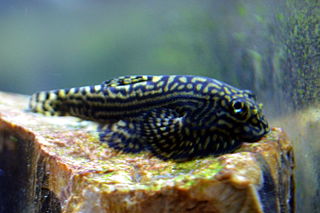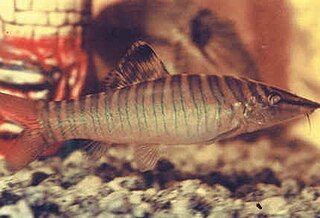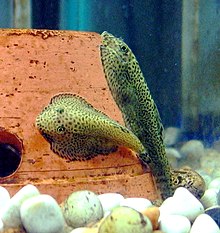
Cypriniformes is an order of ray-finned fish, which includes many families and genera of cyprinid fish, such as barbs, gobies, loaches, botias, and minnows. Cypriniformes is an “order-within-an-order”, placed under the superorder Ostariophysi—which is also made up of cyprinid, ostariophysin fishes. The order contains 11-12 families, over 400 genera, and more than 4,250 named species; new species are regularly described, and new genera are recognized frequently. Cyprinids are most diverse in South and Southeast Asia, but are entirely absent from Australia and South America. At 112 years old, the longest-lived cypriniform fish documented is the bigmouth buffalo.

Cobitidae, also known as the True loaches, is a family of Old World freshwater fish. They occur throughout Eurasia and in Morocco, and inhabit riverine ecosystems. Today, most "loaches" are placed in other families. The family includes about 260 described species. New species are being described regularly.

Water garden or aquatic garden, is a term sometimes used for gardens, or parts of gardens, where any type of water feature is a principal or dominant element. The primary focus is on plants, but they will sometimes also house waterfowl, or ornamental fish, in which case it may be called a fish pond. They vary enormously in size and style.

Plecostomus, pleco, or plec is the common name of several species of freshwater loricariid catfish commonly sold as aquarium fish.

The clown loach, or tiger botia, is a tropical freshwater fish belonging to the botiid loach family. It is the sole member of the genus Chromobotia. It originates in inland waters in Indonesia on the islands of Sumatra and Borneo. In Sentarum, West Borneo that fish named: ulanguli. It is a popular fish in the freshwater aquarium trade and is sold worldwide.
Suckerfish or sucker may refer to:

The term coldwater fish can have different meanings in different contexts.

The pond loach, also known as the Dojo loach, oriental weatherloach or oriental weatherfish, is a freshwater fish in the loach family Cobitidae. They are native to East Asia, but are also popular as an aquarium fish and introduced elsewhere in Asia and to Europe, America and Australia. The alternate name weather loach is shared with several other Cobitidae, including the other members of the genus Misgurnus and the spotted weather loach. This term comes from their ability to detect changes in barometric pressure before a storm and react with frantic swimming or standing on end.

The stone loach is a European species of fresh water ray-finned fish in the family Nemacheilidae. It is one of nineteen species in the genus Barbatula. Stone loaches live amongst the gravel and stones of fast flowing water where they can search for food. The most distinctive feature of this small fish is the presence of barbels around the bottom jaw, which they use to detect their invertebrate prey. The body is a mixture of brown, green and yellow.

The flying fox is a Southeast Asian species of freshwater fish in the family Cyprinidae. It is commonly kept in the aquarium trade. Among other foods, it is known to eat green algae. It is sometimes mistakenly referred to as the Siamese algae eater.

Schistura mahnerti is a species of tropical freshwater fish of the stone loach family Nemacheilidae. It inhabits fast-flowing streams of Thailand and Myanmar (Burma). S. mahnerti is one of the more recent species to be introduced to the aquarium trade.

Beaufortia is a genus of gastromyzontid loaches from China and mainland Southeast Asia.

Pangio myersi is a species of loach in the genus Pangio native to Laos, Cambodia, Viet Nam and Thailand. They are black with orange bands, and can grow to 10 centimetres (3.9 in) SL.

Gyrinocheilus aymonieri is a freshwater fish native to large parts of Southeast Asia. It is of interest as a local food source and for the aquarium trade. Its common names include honey sucker, sucking loach and Chinese algae eater.
The true Kuhli loach, occasionally referred to as eel loach, is a small eel-like freshwater fish belonging to the loach family (Cobitidae). They originate from the island of Java in Indonesia. This snake-like creature is very slender and nocturnal.

Sewellia is a genus of fish in the family Gastromyzontidae. They are commonly called hillstream loaches and are found in Laos and Vietnam. According to Roberts (1998) a possible defining characteristic of the genus Sewellia is their posterior pelvic valve is highly complex and different from other rheophilic loaches, their posterior pelvic valve involves the overlapping of the second to last ventrally exposed rays. Adapted to high velocity streams, Sewellia have depressed body shapes that are laterally expanded, thus increasing their hydrodynamical properties and allowing them to better stay attached to rocks in swift current. Sewellia also have paired fins with a single simple ray and numerous branched rays allowing them to grip rocks in swift current.

Gyrinocheilus is the single genus in the family Gyrinocheilidae, a family of small Southeast Asian cypriniform fishes that live in fast-flowing freshwater mountain streams. The species in this genus are commonly called "algae eaters". They hold on to fixed objects using a sucker-like mouth, and, despite the name, feed on a wide range of detritus, rather than simply on algae. A "golden" variety of G. aymonieri, the Chinese algae eater or "sucking loach", can be found in many pet shops and fish farms.

Syncrossus hymenophysa, commonly known as the tiger loach, tiger botia or green tiger loach, is a species of freshwater fish in the loach family Botiidae. It is native to fast mountain streams and large rivers, over soft substrates and often near submerged boulders and fallen trees, in Peninsular Malaysia, Borneo and Sumatra. Unlike most loaches, S. hymenophysa is very aggressive, especially when food is added to the tank.

Sewellia lineolata, the reticulated hillstream loach, is a species of fish from the provinces of Thua Thien-Hue, Quang Nam, Quang Ngai and Binh Dinh in Vietnam.















